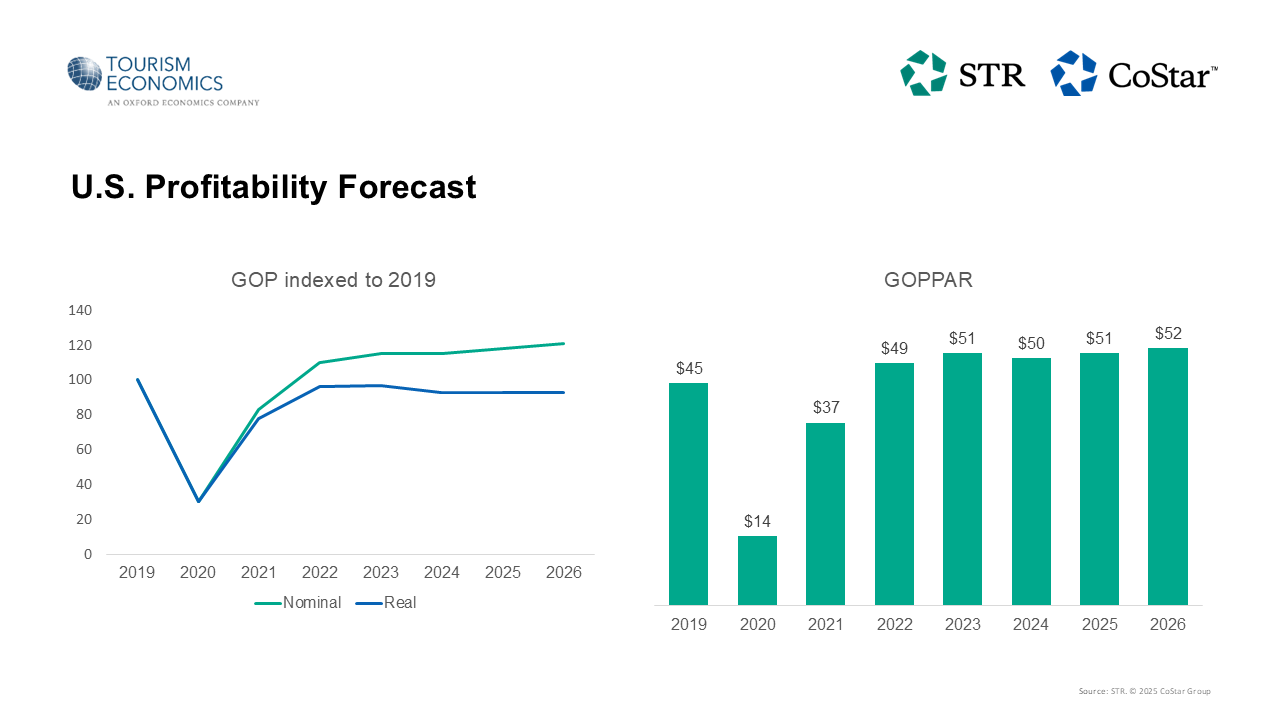Hotels 2026 Trends: Navigating Growth, Risk & Differentiation
Rachel Berntsen
Prepared by Gourmet Marketing, a hotel marketing agency specializing in helping hotels increase direct bookings and revenue through strategic, data-driven marketing solutions.
As we approach 2026, the hospitality and tourism industry faces a more restricted and competitive environment than during the post-pandemic recovery years. The “easy growth” momentum is diminishing, and hoteliers will be evaluated not only by how effectively they meet demand but also by how resilient, adaptable, and distinctive they become.
Hotel performance and operations trends
Below are six key trend areas that will likely determine winners and laggards in 2026, along with practical strategic levers to leverage.
1. Supply growth pressure & segmentation dynamics
What to expect / risks:
- New supply will keep coming online in some U.S. markets, which are forecasted to grow by as much as 1.8% in 2026, with 928 new projects and about 101,796 rooms, according to Lodging Econometrics.
- Much of this supply is focused on upper midscale, upscale, and extended-stay segments, as reported by Hotel Management.
- In markets with slower demand growth, occupancy and rate pressures will increase, especially for undifferentiated assets or those in saturated corridors.
Strategic levers:
-
Niche differentiation: Widely discussed in PwC’s Hospitality Directions and Baker McKenzie’s 2025 sector outlook. Both highlight that midscale and undifferentiated hotels will be squeezed by competition, while boutique, wellness, and experiential hotels will hold rate power.
-
Asset repositioning and renovation: Referenced in CBRE’s Hotel Outlooks and Lodging Econometrics supply forecasts, with a 1.8% new supply growth expected for 2026. Repositioning existing hotels is a common strategy to stay competitive.
-
Selective growth/pipeline control: Common in STR / CoStar & Tourism Economics downgraded forecasts, which warn against aggressive expansion due to tempered demand growth through 2026.

2. Moderated rate growth & revenue optimization
What to expect / risks:
-
Global hotel rates are expected to rise only modestly in 2026, with Amex GBT forecasting incremental ADR growth across key cities (Hotel Business).
-
CoStar / Tourism Economics downgraded their ADR and RevPAR growth forecasts through 2026, citing weaker demand and macroeconomic challenges (STR).

-
Inflation and operating costs will constrain pricing flexibility, while guest price sensitivity stays high.
Strategic levers:
-
Dynamic pricing sophistication: Use advanced revenue management and AI-driven tools to adjust rates based on demand, channel, and segment.
-
Ancillary revenue focus: Increase non-room income sources (F&B, wellness, upsells, packages) to compensate for limited ADR improvements.
-
Segmented pricing: Offer customized packages for premium, corporate, and event travelers to preserve rate power where possible.
3. Guest experience & local immersion as a competitive edge
What to expect / risks:
-
Guests increasingly value authentic, immersive stays; hotels that serve as curators of local culture, food, and experiences will outperform.
-
Baker McKenzie identifies experiential hospitality as a major trend influencing competitiveness by 2026. (Baker McKenzie).
Strategic levers:
-
Localization & partnerships: Work with artisans, guides, and cultural institutions to provide “stay like a local” experiences.
-
Flexible micro-experiences: Let guests customize modular activities — such as cooking classes, wellness rituals, and day tours.
-
Brand storytelling: Incorporate local identity into design, communications, and programming to stand out.
4. Technology & AI as performance multipliers
What to expect / risks:
-
AI is shifting from optional to essential — transforming personalization, forecasting, and operations. Hotels that are slow to adopt risk falling behind.
-
Baker McKenzie and PwC emphasize AI-driven personalization and operational efficiency as key competitive advantages by 2026 (PwC, Baker McKenzie).
Strategic levers:
-
Personalization engines: Leverage predictive analytics to customize offers, upsells, and guest interactions.
-
Operational AI: Use AI for staff scheduling, predictive maintenance, and energy management.
-
Automation & chatbots: Enhance check-in, concierge, and guest service with AI-driven tools.
-
Data infrastructure: Develop clean, integrated data systems (PMS, CRM, guest profiles) to support future applications.
5. Events, demand anchors & volatility management
What to expect / risks:
-
The 2026 FIFA World Cup is expected to create a significant demand spike in North America, along with other global events (AHLA).
-
Shorter booking windows and demand volatility continue to challenge hoteliers, according to STR / CoStar forecasts (STR).
Strategic levers:
-
Pre-event positioning: Start early marketing, develop partnerships, and allocate inventory for flagship events.
-
Demand smoothing: Create off-peak promotions, midweek deals, and loyalty rewards.
-
Event partnerships: Establish collaborations with organizers to secure direct room blocks.
-
Flexible stay options: Provide micro-stays or modular check-in/out to adapt to changing demand patterns.
6. Margin resilience and flexibility under pressure
What to expect / risks:
-
With slower demand growth and higher operating costs (labor, energy, compliance), hoteliers will face increased margin pressure.
-
CoStar / Tourism Economics lowered GOPPAR expectations through 2026, emphasizing the importance of efficiency (Lodging Magazine).
Strategic levers:
-
Margin levers: Manage labor, energy, and maintenance expenses through efficiency programs.
-
Scenario planning: Stress-test portfolios under upside, baseline, and downside scenarios.
-
Dynamic adjustment of policy aspects like cancellation, packaging, and pricing.
-
Selective investment: Allocate capital to ROI-positive projects; postpone discretionary spending.
Final Thoughts
As 2026 approaches, hotels face a balancing act: new supply and cost pressures on one side, and opportunities in technology, experiences, and major events on the other. Success will depend on how well hoteliers adapt, differentiate their offerings, manage margins with discipline, and embrace innovation to meet evolving guest expectations. Those who plan strategically today will be best positioned to navigate growth, reduce risks, and stand out in an increasingly competitive landscape.